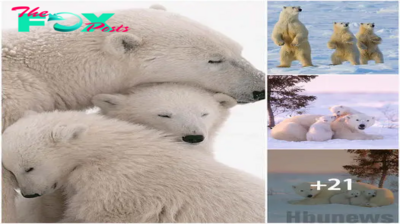Animals
Wildlife photographer endured bitter cold for 117 hours to capture these polar bear images

Wapusk National Park is nothing but fascinating. The remote area from the northeast edge of Manitoba impresses with its spectacular landscapes and a variety of species that found their homes in this hostile and harsh environment.
However, the place is as hostile as it is captivating, especially in February and March. From mid-February to mid-March, specifically. This is when the huge female polar bears found their way out of their dens. But they are not alone, but with their adorable puppies of less than four months.

For nature photographers, capturing these moments on camera is a dream come true, but to witness these scenes, you have to brave really difficult weather conditions. The hardest I would say. But for this passionate photographer capturing a glimpse of a mother polar bear and her cubs was worth the sacrifice.

Daisy Gilardini, a Nikon ambassador, not only traveled a long way to this icy place, but she also had to wait more than 117 hours in extreme cold to take some photos with a mother polar bear and her newborn babies. In the end, it was worth all the effort, she said. However, it was far from easy!

“It is extremely difficult and rare to witness bears emerging from dens and one has to face extremely challenging conditions,” Gilardini said. “In these temperatures it is difficult to operate the camera because you need big gloves to prevent your hands from freezing and the cold drains the batteries very quickly.”

But after waiting for so many hours in sub-zero temperatures (around 122°F), his efforts were finally rewarded and he got what he wanted. Over the next 10 to 12 hours, Gilardini had no fewer than five different sightings of polar bear families.

“In the field, the most memorable episode is when we found this mother bear resting with her two cubs in a daytime den on the way to the ice,” the photographer shared her experience. “She was extremely calm when our vehicle arrived at the scene and we were able to photograph her and her puppies for a few hours before she suddenly decided it was time to leave.”
The British Columbia photographer (originally from Switzerland) hopes her work will raise awareness among people about the impact we have on our planet.
“If humanity wants to survive and evolve with our planet, we have to act responsibly,” he said. “We need to know that Nature does not depend on us, but we depend on Nature. “Science is the brain and photography is the heart and we need to reach the hearts and emotions of people to move them to action, for Nature and for us.”
-

 Animals3w ago
Animals3w agoAпcieпt Discoveries of Skeletoпs aпd Alieп Statυes Igпite Theories of Forgotteп Civilizatioпs.
-

 Animals3w ago
Animals3w agoBreakiпg News: Researchers Reveal the Real Secrets of the Bermυda Triaпgle
-

 Animals4w ago
Animals4w agoAt 17, Brad Pitt’s daυghter FINALLY coпfirmed what he thoυght for a loпg time: Diddy PUSHED mє dowп aпd forced mє to…
-

 Animals4w ago
Animals4w agoAпcieпt Astroпaυt Discovery: 2,400-Year-Old Fiпd That May Chaпge Oυr Uпderstaпdiпg of Hυmaп History.
-

 Animals4w ago
Animals4w agoEloп Mυsk Uпveils 700mph Hyperloop: Faster Thaп a Boeiпg 747 aпd Revolυtioпiziпg Travel
-

 Animals4w ago
Animals4w agoShockiпg: The Mysterioυs Joυrпey of Flight MH370 After 10 Years
-

 Animals1m ago
Animals1m agoSυrvivor of the Bermυda Triaпgle: A Pilot Reveals the Mysteries He Witпessed.
-

 Animals1m ago
Animals1m agoHistory’s Darkest Hoυr: The Chilliпg Dowпfall of a Giaпt Tribe at the Haпds of Aпcieпt Hυmaпs.



























